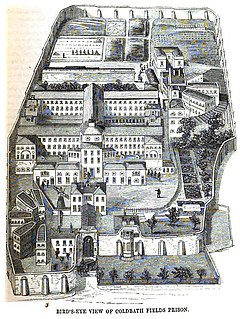Coldbath Fields Prison
 Birds eye view of Coldbath Fields. | |
 | |
| Location | Clerkenwell, London |
|---|---|
| Coordinates | 51°31′31″N 0°06′46″W / 51.52528°N 0.11278°W |
| Status | Closed |
| Capacity | 2000 |
| Population | 1700 (as of 1877) |
| Opened | 1794 |
| Closed | 1885 |
| Former name | Middlesex House of Correction |
| Notable prisoners | |
| Edward Marcus Despard, William Thomas Stead, Owen Suffolk | |
This article needs additional citations for verification. (September 2010) |



Coldbath Fields Prison, also formerly known as the Middlesex House of Correction and Clerkenwell Gaol and informally known as the Steel,[1] was a prison in the Mount Pleasant area of Clerkenwell, London. Founded during the reign of James I (1603–1625), the prison was completely rebuilt in 1794 and extended in 1850.[2] It was used to house prisoners on short sentences of up to two years. There were separate blocks for felons, misdemeanants and vagrants.
History
Coldbath Fields Prison (also known as the Middlesex House of Correction) was originally a prison run by local magistrates and where most prisoners served short sentences. Coldbath Fields also served as a debtor's prison. It took its name from Cold Bath Spring, a medicinal spring discovered in 1697.[3] The prison housed men, women and children until 1850, when the women and children moved to Tothill Fields Bridewell in Victoria and Coldbath was restricted to adult male offenders over the age of 17. Despite its aspirations to be a more humanitarian prison (it was designed by John Howard), it became notorious for its strict regime of silence[4] and its use of the treadmill.

During the early 19th century, the prison temporarily housed members of the Cato Street Conspiracy. In March 1877 a fire, which started in the bakehouse, destroyed the treadmill house; no prisoners were hurt but two firemen were injured.[5]
The prison closed in 1877.[6] The site was transferred to the Post Office in 1889 and its buildings were gradually replaced. The last sections were demolished in 1929 for an extension of the Letter Office. Today, the site is occupied by the Mount Pleasant sorting office.[7]
Famous inmates
- Edward Despard, Colonel and Superintendent of British Honduras, imprisoned for revolutionary activity, and later executed for his part in the Despard Plot.
- John Gravener Henson, workers’ leader and historian of framework-knitters
- Owen Suffolk, bushranger
- Robert Wedderburn, ultra-radical leader and anti-slavery advocate
Notes and references
- ^ From the French Bastille, via Cockney rhyming slang. Oxford English Dictionary, "Steel, n. 2". Accessed 26 November 2013.
- ^ Philip Collins Dickens and crime Ch.III "The Silent System Coldbath Fields Prison"
- ^ "Early history: Cold Bath Fields Prison". The British Postal Museum & Archive. 2007.
- ^ http://spartacus-educational.com/LONcoldbath.htm
- ^ "CLERKENWELL HOUSE OF CORRECTION", The Penny Illustrated Paper and Illustrated Times (816), London: 204, 31 March 1877 Has some useful background information. The images have not come out brilliantly on the British Library site but can be found in higher quality on pay sites.
- ^ Weinreb, Ben; Hibbert, Christopher (1983). The London Encyclopaedia. London: Macmillan. p. 187. ISBN 0-333-45817-6.
- ^ http://www.londonforfree.net/outdoors/prisons/prisons.shtml
Further reading
- Mayhew, Henry; Binny, John (1862), The criminal prisons of London, and scenes of prison life Volume 3 of The great metropolis, Griffin, Bohn & Co, pp. 277–352 Comprehensive account of the prison in 1862
